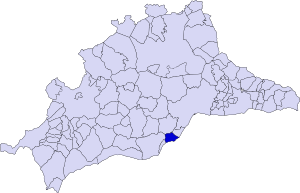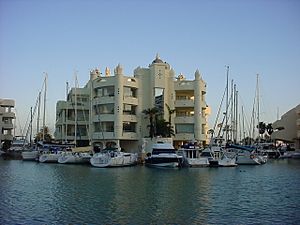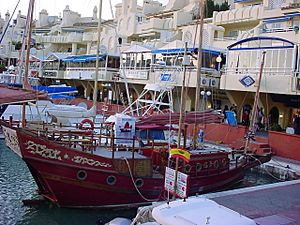Benalmádena facts for kids
Quick facts for kids
Benalmádena
|
|||
|---|---|---|---|

Benalmádena Cable Car
|
|||
|
|||

Benalmádena shown within Málaga
|
|||
| Sovereign state | |||
| Autonomous community | |||
| Province | |||
| Comarca | Costa del Sol Occidental | ||
| Administrative HQ | Benalmádena | ||
| Government | |||
| • Type | Municipal corporation | ||
| • Body | Ayuntamiento de Benalmádena | ||
| Area | |||
| • Total | 27.2 km2 (10.5 sq mi) | ||
| Population
(2018)
|
|||
| • Total | 67,746 | ||
| • Density | 2,491/km2 (6,451/sq mi) | ||
| Demonym(s) | Benalmadenses | ||
| Time zone | UTC+1 (Central European Time) | ||
| • Summer (DST) | UTC+2 (Central European Summer Time) | ||
| Postal codes |
29630
29631 29639 |
||
| Dialling code | 95 | ||
| Website | www.benalmadena.es | ||
Benalmádena is a fun town in southern Spain, located in Andalusia. It's about 12 kilometers west of Málaga, right on the sunny Costa del Sol. You'll find it between the towns of Torremolinos and Fuengirola.
This town is famous for its beautiful beaches and cool places to visit. Some highlights include the amazing Colomares Castle, the huge 33-meter-tall Buddhist Benalmádena Stupa (the biggest in Europe!), the lively Benalmádena Marina, and the exciting Benalmádena Cable Car.
Benalmádena covers an area of just over 27 square kilometers. It stretches from the top of the Sierra de Mijas mountains all the way to the sea. In some spots, the land drops steeply like a cliff! A main highway, the A-7, runs through the area, connecting it to Málaga and other coastal towns.
In 2010, Benalmádena had about 61,383 people living there. This makes it one of the biggest towns in its province. The population is spread across three main areas: Benalmádena Pueblo, Arroyo de la Miel, and Benalmádena Costa. However, with lots of new buildings, these areas are starting to connect.
People have lived in Benalmádena since ancient times. It grew a lot when Muslims ruled the area. But after it became part of the Crown of Castile in 1485, its growth slowed down due to natural disasters and pirate attacks. Later, in the 18th and 19th centuries, paper making and growing grapes helped the local economy bounce back.
Today, Benalmádena is a top tourist spot on the Costa del Sol. It has many fun things to do, like an amusement park, two aquariums, a casino, a cable car, and one of the largest marinas in Andalusia.
Contents
Discovering Benalmádena's Past
Benalmádena has a long and exciting history! Many different cultures have lived here since the Bronze Age. These include the ancient Phoenicians and Romans. The area was also greatly shaped by the Moors, who settled in southern Spain.
You can still see two old watchtowers, called Almenara towers, along the coast. They were built in the 15th century to protect the people from frequent attacks by Barbary pirates. This was after the Christian armies had taken back the region from Muslim rule.
Today, Benalmádena is a very popular place for tourists. Like other areas on the Costa del Sol, it has seen many new buildings and homes built recently.
What Does "Benalmádena" Mean?
Historians have different ideas about where the name "Benalmádena" comes from. The first time the name appeared in writing was in the 15th century. This was during the time when the Crown of Castile was trying to take back land from the Nasrid Kingdom of Granada.
Most historians agree that the name likely comes from an Arabic phrase, Ibn al-ma' din. This means "son of the mines," because iron and ochre (a type of earth used for color) were found in the area. Another idea is that it comes from Bina al-ma'din, meaning "the construction or building of the mine."
Some other theories suggest it means "people between springs" (Bena-A La Ena). Or maybe it came from Bina al-Madina, meaning "the state of the al-Madina's family." The al-Madina family was a rich Muslim family from Málaga who might have owned the area.
Early Settlers: Before the Romans
The very first people lived in this area about 20,000 years ago, during the Upper Palaeolithic period. We know this from things found in local caves like "Cueva del Toro" and "Cueva del Botijo."
Around 800 to 700 BC, the Phoenicians arrived. They were interested in the mines here and set up many colonies along the Spanish coast. Later, the Romans took over from the Phoenicians as traders. They also used the rich resources of the Mediterranean.
You can still see Roman ruins in Benalmádena, like the remains of a fish-salting factory called Benal-Roma. There are also artifacts like enamelware in the Benalmádena Museum. Growing grapes for wine was very important during the Roman time.
The Middle Ages and Muslim Rule
After the Romans, the area became less populated. People moved inside Málaga's city walls to be safe from attacks from the sea. The region was then ruled by Visigoths and Byzantines.
But after the Muslim invasion of the Iberian Peninsula, Benalmádena grew a lot. By the 11th century, people lived in a walled town with a fortress in "Benalmádena Pueblo." Muslims improved farming and brought new crops like sugar cane, figs, grapes, and mulberry trees (used for making textiles) from the East. A very important botanist and doctor from the Middle Ages, Ibn al-Baitar, was born here in 1197.
From Conquest to Modern Growth
In 1456, Christian armies led by King Enrique IV of Castilla destroyed the fort and town. The villagers fled to Mijas. The town was destroyed again in 1485 by King Ferdinand the Catholic during his final conquest. For six years, the town was empty.
In 1491, the king tried to get people to live there again. But an earthquake and constant pirate attacks made it too hard. It was around this time that the Arabic name changed to the Castilian "Benalmaina."
A big change happened in 1784. An Italian man named Félix Solesio bought a farm called "Arroyo de la Miel." He built six paper factories there to supply a royal playing card factory. Most of the paper went to America. This led to the growth of Arroyo de la Miel around these new businesses.
In the 1800s, the town grew by producing wine from muscatel grapes. However, a plant disease called phylloxera destroyed grape crops across the whole province. Diseases like malaria and cholera also affected the population.
Benalmádena's population really started to boom in the 1950s. This was when mass tourism began to grow on the Spanish coast. Many hotels, restaurants, and businesses opened during this time. Some famous places include the Hotel Triton (1961), Tivoli World amusement park (1973), and the Torrequebrada casino (1979). More attractions like the Selwo Aquarium, Sea Life Aquarium, and the Cable Car were built later.
Exploring Benalmádena's Geography
Benalmádena has three main areas, each with its own special feel:
- Benalmádena Pueblo: This is the original village, located about three kilometers inland and around 200 meters above sea level. It looks like a classic white-painted Andalusian village, though it also has many newer buildings. The town's archaeological museum here has ancient items from the Bronze Age.
- Benalmádena Costa: This is the lively coastal area. Here you'll find discos, hotels, beaches, shopping centers, and a large, well-equipped marina. Popular tourist spots include the SeaLife aquarium and Selwo Marina, which is a theme park with dolphins, penguins, and seals. Parque Paloma is a beautiful park with a big lake and animals roaming freely.
- Arroyo de la Miel (Honey Stream): This area was once a separate village. It's located between the Pueblo and the Costa. Now, it's the main place where people live and where most of the shops and businesses are. It has many apartment buildings. Fun attractions here include the Tivoli World amusement park and a teleferico (a cable car). The cable car takes you to the top of Mount Calamorro, which is 769 meters high. From there, you can see amazing views of the Sierra Nevada mountains, Gibraltar, and even the Moroccan coast on clear days! The Friday market is also a popular place to visit.
Benalmádena's Climate
Benalmádena has a typical Mediterranean climate. This means it has mild temperatures all year round. It almost never freezes in the colder months, and the average temperature is about 19 degrees Celsius (66 degrees Fahrenheit). This great weather and its location on the southern coast of Europe are big reasons why tourism is the main industry here.
Plants and Animals
Benalmádena is a very developed area, with lots of buildings. But in the higher mountain areas, you can still find natural spaces. Here, you'll see plants common in the Mediterranean, like white deadnettle, rock rose, thyme, rosemary, and marjoram. There are also trees like the turpentine tree, juniper, pine, carob tree, and wild olive.
For animals, you might spot mountain goats, genets (a type of cat-like animal), different kinds of reptiles, eagles, kestrels, and owls. Sometimes, whales and other sea creatures are seen along the coast!
Famous Landmarks and Fun Places
Benalmádena is home to the largest Buddhist stupa in the Western world, called the Benalmádena Stupa. It was built in 2003 and is a very peaceful place.
In Arroyo de la Miel, on Avenida Garcia Lorca, you can find the only real ice skating rink on the Costa del Sol.
-
Colomares Castle, a fairy-tale-like monument.
Getting Around Benalmádena
Benalmádena is part of the Málaga Metropolitan Transport Consortium. This means you can use one ticket for both metropolitan and local buses, as well as the Cercanías Málaga train and Metro de Málaga (subway).
The town is on the C1 line of the Cercanías Málaga railway. This train goes from Málaga, past the Málaga-Costa del Sol Airport, all the way to Fuengirola. Trains run every 20 minutes. The main train station in Benalmádena is Arroyo de la Miel, and there's another one at Torremuelle.
Sister Cities
Benalmádena has special connections with other towns around the world, called "twin towns" or "sister cities." These connections help promote friendship and understanding.
 Finale Ligure, Italy
Finale Ligure, Italy Nuevitas, Cuba
Nuevitas, Cuba Beyoğlu, Turkey
Beyoğlu, Turkey
Famous People from Benalmádena
Many interesting people have connections to Benalmádena:
- Scientist
- Ibn al-Baytar: A very important botanist and doctor from the Middle Ages.
- Artists
- Imperio Argentina: A famous actress and singer.
- Politicians
- Celia Villalobos: A well-known politician.
- Sportspeople
- Iván Aguilar: A football player.
- José Antonio Crespo: A badminton player.
- Isco: A famous football player.
- Junior Firpo: Another talented football player.
See also
 In Spanish: Benalmádena para niños
In Spanish: Benalmádena para niños















